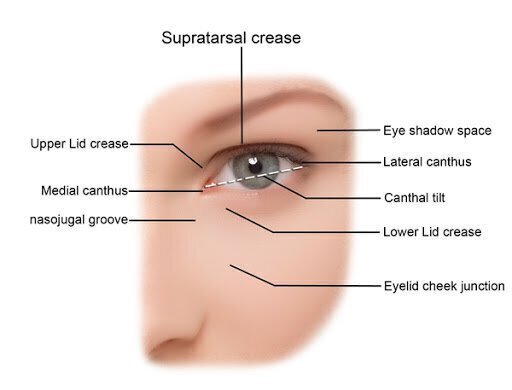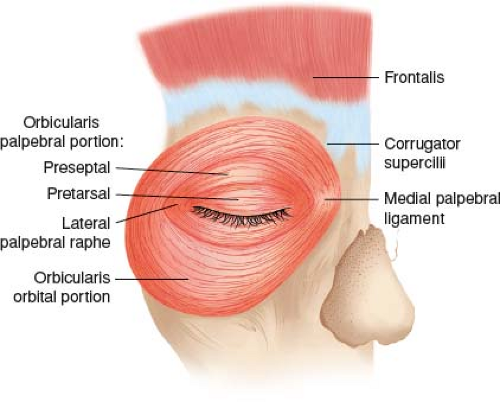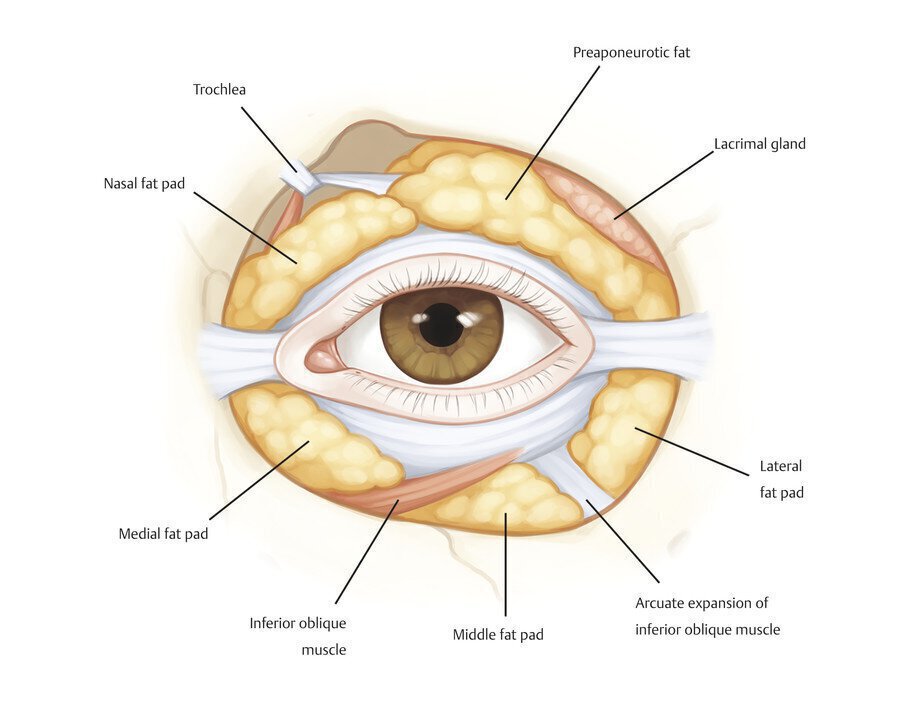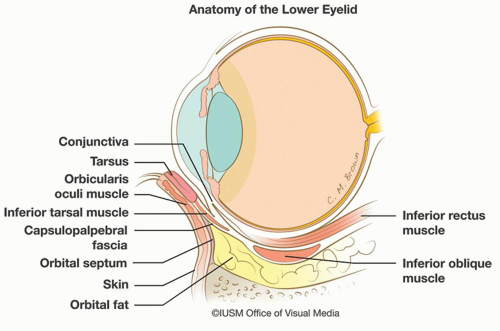








Lower eyelid rejuvenation is one of the most effective procedures available for aesthetic improvement of the face at Ocean Drive Plastic Surgery. Because of its complex anatomy and central location, rejuvenation of the lower eyelid provides a global improvement to the entire face.
There are multiple anatomic layers in the lower eyelid, and they all contribute or detract from your appearance.
External Skin and Orbicularis Muscle (Also called the Anterior Lamella)
The lower eyelid is defined as the area between the lower eyelashes and the line where the lower eyelid becomes the cheek (aka the lid-cheek junction). Within this area, there are three major anatomic layers that work in tandem to produce your lower eyelid appearance, and provide coverage to the lower pole of your eye.
The most obvious layer is the external skin. The lower eyelid is invested with some of the thinnest skin in the human body, and as such, it tends to reflect the signs of aging earlier than other areas because it has less dermis for support, and because it is located centrally in the human face. Sunlight, airborne toxins such as smoke, and metabolic factors such as poor diet or lack of sleep can easily manifest in the lower eyelid skin due to its relatively thin profile, and due to its central location, this manifestation can appear prominent in both real life, and in photography. When planning lower lid blepharoplasty, clinical analysis of the lower eyelid skin is crucial towards success.
The orbicularis oculi muscle lives directly underneath the skin plane of the lower eyelid. It assists in maintaining lower eyelid position, and is an accessory muscle for blinking. This muscle has three separate areas: Pretarsal, Preseptal, and Preorbital. The pretarsal and preseptal parts overlie the soft tissue components of the lower eyelid, while the preorbital component lives on top of the orbital bone. The orbicularis muscle plays an important role in eyelid position and function.
The Septum (also called the Middle Lamella)
The lower eyelid septum is essentially a thin wall which separates the orbicularis muscle and skin from the fat pads of the lower eyelid. This critical structure helps to maintain lower eyelid position and function. The integrity of this structure also has a significant impact on lower eyelid aesthetics, as a weak septum is one of the major contributing factors to “lower eyelid bags”.
Lower eyelid fat pads
There are three fat pads that live in the lower eyelid. These fat pads are what drive people into our office for “bag removal”. The pads are shown below. In between the medial and middle fat pads lies a very important muscle called the inferior oblique muscle. This muscle is not altered during lower lid blepharoplasty, and in general is identified and avoided to minimize alteration of lower eyelid function.
The tarsal plate and the conjunctiva (also called the posterior lamella)
The tarsal plate is the horizontal structure that holds the lower lid eyelashes. This dense connective structure serves as the “clothesline” of the lower eyelid. It should have a slight tilt upwards as it proceeds from the nose side to the ear side of the face, which is referred to as Positive Canthal Tilt . The tarsal plate itself is commonly repositioned during lower eyelid surgery to minimize chances of eyelid malposition, and to improve or re-establish positive canthal tilt. Dr. Durkin strongly believes in creating or maintaining positive canthal tilt in his lower lid blepharoplasty procedures, regardless of the approach type.

Arcus marginalis – This structure refers to the junction of the the septum and the covering of the orbital bone (aka the periosteum). This structure is commonly released during lower eyelid surgery
Orbitomalar ligament – This is a ligament that projects from the bone to the skin at the level of the arcus marginalis. It is commonly released in patients who have a prominent line between their eyelid and their cheek
Medial Canthus – This is the confluence of the upper eyelid and lower eyelid on the nasal side of the eye.
Lateral Canthus – This is the confluence of the upper eyelid and lower eyelid on the ear side of the eye.
Lower eyelid blepharoplasty refers to a group of procedures, rather than a single uniform one.
Now that you have seen the rich tapestry of lower eyelid anatomy, it should be obvious that with the lower eyelid, not one single procedure will satisfy all patients. Rather, it is incumbent upon the plastic surgeon to clearly identify the individual structures that require improvement prior to undertaking lower eyelid blepharoplasty. In some cases, the skin quality is excellent, and without excess, but there are prominent fat pockets.
In other cases, there is excess skin as well as prominent bags. Many patients want to improve their canthal tilt, but do not have any excess skin or fat. Because of this, the most critical component for success with lower eyelid surgery is experience. At Ocean Drive Plastic Surgery, Dr. Durkin routinely provides the entire spectrum of lower eyelid blepharoplasty. We will go through the different types of lower lid blepharoplasty below.
These patients can be treated non-surgically with a combination of injectable fillers and laser therapy. Results are outstanding, and can last over a year without further therapy. This type of lower eyelid rarely requires surgical treatment, but a skin-only blepharoplasty can be considered in this scenario. However, most patients with this type of lower eyelid proceed with a combination of injectables and laser therapy. We commonly use Restylane-L and Belotero Balance, but can also provide fat grafting for those looking for longer lasting results.
In this instance, we undertake what is known as a Transconjunctival approach, and combine it with external laser resurfacing to firm up the superficial skin following fat removal. This approach is unique in that there is NO EXTERNAL SCAR. For patients with good overall skin, but prominent lower eyelid bags, this procedure is tailor made for you. It addresses only the issue at hand, without any unnecessary trauma to your eyelid. Recovery is usually within 5-7 days. This approach can be done with local anesthesia, but we strongly recommend use of a “twilight” level of sedation. Patients who present with neutral or negative canthal tilt will also undergo canthoplasty to produce positive canthal tilt. Results are very durable, lasting upwards of 15 years with proper maintenance.
This presentation requires a more thorough approach to create a natural, harmonious result. In this instance, two separate incisions are made in the eyelid: one in the transconjunctival plane (inside the eyelid), and one in the transcutaneous plane (externally along the eyelid skin. This combined approach allows Dr. Durkin to remove fat as needed, as well as skin. The external incision is placed underneath the lower eyelid lash line, and is hidden within the lateral “crows feet” wrinkles of the eyelid. In cases of skin excision, Dr. Durkin strongly believes in maintaining lateral support for the lower eyelid, and always provides a canthoplasty to enhance canthal tilt, and minimize the chances of eyelid droop (aka ectropion). Recovery from this procedure is usually 7-10 days. This approach is provided with a “twilight” level of anesthesia. Results are very durable, lasting upwards of 15 years with proper maintenance.
This type of presentation is treated with a lower eyelid “septal reset” procedure. One of Dr. Durkin’s favorite procedures, the septal reset allows comprehensive treatment of the lower eyelid bags, tear trough, and excess skin. This is our most advanced procedure for lower eyelid blepharoplasty. With this procedure, an incision is made on the external skin, and the skin and muscle are released from the septum. The septum is then advanced downwards to cover up the line between the lower eyelid and the cheek (aka the tear trough). Prior to advancement, any excess fat is removed from the lower eyelid fat compartments. After insetting the new septal position, excess skin is trimmed away, and the muscle is used to lift the lower eyelid upwards and laterally. Lastly, a canthoplasty is undertaken to provide positive canthal tilt.

Surface anatomy of the upper and lower eyelids is shown here. Note the dashed line through the eyelid, as it represents what is called positive canthal tilt.

The three components of the orbicularis muscle. The pretarsal and preseptal components are more mobile than the preorbital component, but all three contribute to lower eyelid appearance, tone, and function.

The diagram shows the relative positions of the lower eyelid fat pads. The lower eyelid has three fat pads: medial, central/middle, and lateral. Each of these can individually create a lower eyelid bag. In many cases, patients think they have only “one bag”, but in fact, they usually have three.

This diagram shows the septum “holding back” the lower eyelid fat pads, as well as the position of the orbitomalar ligament.
You may shower when cleared by Dr. Durkin. When cleared to shower you may wash your face gently cleansing the incisions with soap and water. Avoid “scrubbing” the incision sites. Use a gentle massage with your fingertips around the incisions. Wash the incision sites twice daily. Place the artificial tear ointment, which was given to you at your pre-op visit with the nurse, on the incisions after washing. An eyelid exercise handout will be given to you after your surgery. Be sure to practice the exercises every day to avoid scarring. An antibiotic has also been given to you. This is begun the day after surgery and continued until gone.
Limit your activity over the first week following your eye. surgery. We encourage walking, but AVOIDING bending over at the waist, or picking up heavy objects, or straining in any way. If you overexert yourself, bleeding may result. You may slowly resume your activities after the first week, but please avoid any strenuous activity until Dr. Durkin gives you the OK. If the activity involves being outside please use the appropriate protection from the sun (sunscreen, hat, etc.), even a mild sunburn may cause prolonged swelling and/or irritation of the incisions and skin.
Every operation, no matter how minor, is accompanied by swelling of the surrounding tissues. The amount varies from minimal to extensive. Sometimes the swelling becomes a little greater 48 hours after your operation and will gradually decrease. Swelling is generally worse when you first get up in the morning. The swelling itself is not serious and is not an indication that something is going wrong with your operation. It may take several weeks for the swelling to diminish completely. After the swelling diminishes though, you may notice or feel some unevenness (lumpiness) under the skin; this will gradually disappear. The main thing to remember is the swelling eventually subsides; you can help in several ways:
Soft washcloths or the ice packs that we provide to you can be used. If you decide to use a soft cloth, dip in water with ice chips. They may be placed in a plastic wrapper such as a baggie to avoid wetting your clothing. Apply your preferred method across the eyes for twenty minutes several times daily during the first 3 days may help reduce swelling, discomfort, and discoloration.
There is usually little actual pain following a blepharoplasty, but you may experience a deep bruised sensation as a result of the swelling, and the eyes may seem heavy, this can seem worse at night. You will receive a prescribed pain medication and it can often cause sensations of light-headedness or sleepiness, particularly in the immediate post-operative period. If you choose to not take the pain medication prescribed you may try the application of cold compresses. Under no circumstances should ASPIRIN, IBUPROFEN, or medications containing aspirin or salicylates or ibuprofen, be taken without first consulting us. If the pain is severe and the prescribed pain medication is not helping please do not increase the recommended dosage or supplement with your own medications. Notify our office and we will evaluate the next step in controlling your pain.
Discoloration and bruising are normal. Like the swelling, it may become more pronounced after the first day or so but remember this is temporary.
Every post-op patient will receive the following four meds which may be adjusted due to medication allergies etc.
The night of your surgery you may feel nauseated. We have provided you with anti- nausea medication. You can take the medication and only take a few ounces of clear fluids until the nausea passes. There are no restrictions to what you can and can’t eat. Please no drinking of alcohol for the first 3 weeks and/or while taking the pain medication and the anti-anxiety medication. Alcohol may raise the blood pressure and initiate bleeding.
When you should return to work depends on the amount of physical activity and public contact your job involves and also the amount of swelling and discoloration you develop; the average patient may return to work or go out socially 2-3 weeks after surgery when these factors are minimal, you will have to play this by ear! Do not drive if you’re taking the pain medication.
Remember the things you were told before your operation, namely:
If you have any questions or concerns, please do not hesitate to contact the office at (772) 234-3700. If you have an emergency after regular office hours, please call 911 or go to your local emergency room.
If you're looking for alternatives to surgery for your treatment? Ocean Drive MedSpa has the perfect non-surgical solution for you. Our expert team offers non-surgical face treatments that can help you achieve a more youthful and refreshed appearance without the need for surgery. Our state-of-the-art techniques and technologies are designed to lift and tighten the skin, giving you a more youthful and radiant look. Plus, with our minimally-invasive approach, you can enjoy quick and easy recovery with no down time. Explore our website to learn more about our non-surgical face treatments and schedule a consultation today to take the first step towards a more youthful you.
Visit Ocean Drive MedSpa
At Ocean Drive Plastic Surgery in Vero Beach, Dr. Alan Durkin and their team of providers deliver incredible results tailored to your needs in a relaxing and uplifting atmosphere. Learn more about the Ocean Drive difference by scheduling your one-on-one diagnostic consultation with Dr. Durkin or Dr. Chim today.